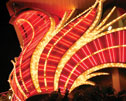In the heart of Minneapolis' thriving Warehouse District, amidst a plethora of restaurants, bars, theaters, hotels and shopping venues, is the Target Center, one of the Midwest's largest entertainment facilities. Owned by the city and sponsored by Target Corp., which is based in Minneapolis, the arena encompasses 831,533 square feet and can accommodate up to 20,500 people. Since opening Oct. 13, 1990, the center has hosted about 4,000 events and welcomed about 25 million people.
The center, originally constructed for and owned by the Minnesota Timberwolves, was purchased by the city in 1995. When it came time to replace the center's 20-year-old roof system, the city undertook a project to install a vegetative roof system on the 2 1/2-acre main low-slope roof, as well as reroof 29 smaller roofs on five lower levels of the building.
The project was put out for public bid in September 2008, and Stock Roofing Co. LLC, Fridley, Minn., a Tecta America company, was awarded the project Jan. 29, 2009.
The installation and ongoing maintenance of the 113,000-square-foot vegetative roof system—the fifth largest extensive vegetative roof system in the U.S. at the time of its installation—is the project's final stage.
Setting goals
Architect LEO A DALY, Minneapolis; landscape architect Kestrel Design Group Inc., Minneapolis; and roofing and waterproofing consultant Inspec Inc., Minneapolis, designed the project and vegetative roof system with several goals in mind.
Primarily, the city selected a vegetative roof system for the building's main roof as part of its sustainability initiative; at more than 2 1/2 acres, the roof system has the potential to mitigate a significant amount of storm water runoff. The system is designed to retain up to 0.9 inches of rainfall without runoff, capturing almost 1 million gallons of storm water annually and preventing drainage into the Mississippi River. Additionally, the roof system is intended to help mitigate the heat island effect in downtown Minneapolis by reducing the roof surface's ambient temperature compared with a typical roof system.
The city set another goal for the project: Recycle a minimum of 50 percent of the construction debris and tear-off materials. Stock Roofing decided to take that goal a step further and set its own goal: to recycle 100 percent of the materials.
Recycling the roofs
Stock Roofing began work on the Target Center in May 2009.
"Our crews were anywhere from 10 to 40 workers—we had split crew locations and responsibilities," says Rex Greenwald, Stock Roofing's environmental solutions specialist and project executive for the Target Center project.
The crews began by tearing off the existing roof systems on all 30 roof areas; the smaller roof areas total about 22,000 square feet.
"On all the roof areas, we tore off the existing ballasted EPDM membrane and 4 3/4-inch-thick multiple-layered polyisocyanurate insulation to the deck," Greenwald says. "The ballast consisted of washed river rock and concrete pavers. About 400 tons of rock and 580 tons of pavers were removed."
Additionally, about 40 tons of EPDM roof membrane and 60 truckloads of roof insulation were removed and recycled.
"We ended up recycling almost 100 percent of the existing materials," Greenwald says.
Green acres
After tear-off was complete, Stock Roofing crew members began installing the center's new roof systems; over the main roof's 22-gauge acoustical steel deck and the 29 smaller roof areas' concrete deck, crew members mechanically fastened two layers of 2-inch-thick polyisocyanurate insulation followed by another layer of 2-inch-thick polyisocyanurate insulation installed in Millenium Weather-Tite adhesive.
"Over the insulation layers, we laid an electric field vector mapping (EFVM) system; the EFVM system's primary component is a screen layer installed under the waterproofing layer," Greenwald says. "The screen will serve as the conductor when attempting to pinpoint the locations of leaks, if required. We then installed 1/4-inch-thick DensDeck Prime® cover board in adhesive over the roof insulation assembly."
Next, on the smaller roof areas, a 60-mil Sarnafil G410 Energy-Smart Roof® Membrane was fully adhered to the cover board followed by a protection mat and pavers; this concluded installation of the smaller roofs.
On the main roof, an 80-mil-thick Sarnafil G476 Self Adhered Waterproofing PVC Membrane was fully adhered to the cover board.
"The waterproofing membrane and other vegetative components will withstand constant dampness; high alkalinity; exposure to plant roots, fungi and bacterial organisms; and varying hydrostatic pressures," Greenwald says.
Crew members then installed a drainage mat with a root barrier followed by a geotextile water retention mat. A full-drip irrigation system was installed to provide water during plant establishment and droughts; about 11 miles of water-efficient irrigation lines were installed and 14,000 concrete pavers for firebreaks and roof system protection were laid, according to Greenwald.
Next, the growth media was placed on the roof system.
"The ingredients of the rooflite® growth media we used for the project were mixed in Minneapolis next to the Mississippi River, and the many truckloads of growth media were then brought to the project site," Greenwald says. "This operation allowed us to employ more local workers—a project requirement by the city."
More than 540 cubic yards of growth media were installed on the rooftop between 120 and 165 feet above street level. The roof has a 2 3/4-inch-deep growing zone at its center and a 3 1/2-inch-deep growing zone around the roof perimeter where the structural capacity is greater to maximize storm water retention and plant growth.
During a two-day span, a 165-ton crane hoisted five truckloads of plant material to the rooftop, including 900 rolls of pre-grown vegetated mats of sedum and native plants.
"To complement the pre-grown vegetation and provide some variety, we also planted more than 25,000 plugs and 4,000 pounds of specific plant seeds on the roof," Greenwald says.
The completed vegetative roof features a variety of sedums and Minnesota prairie plants, including columbine, prairie coreopsis, wild strawberry, dotted blazing-star and lupine. Lupine was selected to attract the Karner Blue butterfly, a federally listed endangered butterfly that requires lupines to survive.
Solving problems
Considering the sheer size of the Target Center replacement project and number of parties involved, there were bound to be some complications; getting the massive amounts of materials on and off the roof areas was a major one.
Greenwald says: "The building is downtown and surrounded by four busy city streets, so we had to work with the city for lane closures and specific times of operations requirements.
"To make matters more complicated, the new Minnesota Twins stadium was being constructed across the street at the same time we were performing work," he continues. "We had to communicate with those working on the new Twins stadium because they were having materials delivered, as well. We also had to stagger deliveries of our materials because we obviously couldn't have it all brought at once."
Stock Roofing also had some difficulty accessing the various roof areas.
"We erected scaffolding and used lift trucks in some areas," Greenwald says. "A few of the smaller roof areas were only about 5 by 8 feet and 165 feet up with no access, so workers had to work off lifts."
Additionally, Stock Roofing had to work around the Target Center's schedule.
"The Target Center is an event-based venue; we had to make sure our work did not affect its money-making source of operations," Greenwald says. "There were more than 60 events held while the project was going on, including basketball games, concerts, circus events, wrestling matches, etc. When there was an event taking place, we sometimes had to stop work and make up the time during the night. We had to be in constant communication with the building owner."
Everybody's watching
During the Target Center project, safety took on even more importance than usual—in part because the job was so high-profile.
"This was a busy construction area with the new Twins stadium being built at the same time across the street," Greenwald says. "The Occupational Safety and Health Administration (OSHA) was well-aware of the projects, and OSHA inspectors were all over the place. Our company policy is to have every employee wear a hardhat, safety glasses, boots and harnesses at all times—even in situations when OSHA doesn't require their use."
Stock Roofing provided all its employees fall-protection training, training regarding safety harness use and daily safety talks. Additionally, all employees had mandatory drug testing and a pre-employment physical, and the site was secured, meaning all workers had to go through Target Center security upon arrival at the job site.
"We made sure we went above and beyond what is required," Greenwald says. "Safety is our No. 1 goal. We want to do whatever we can to make sure all our workers go home to their families."
However, OSHA personnel weren't the only ones with their eyes on Stock Roofing.
"Minneapolis is a pretty progressive community," Greenwald says. "There is a lot of emphasis on sustainability and energy efficiency. Still, not everybody thinks that way, and a lot of people thought the extra money invested to install a vegetative roof was not money well spent. We knew people were watching us like hawks, and we had to put our blinders on."
A team effort
The Target Center vegetative roof system installation—Minnesota's largest vegetative roof at the time and the first vegetative roof to be installed on an arena in North America—was completed on time in October 2009. And the new roof was received with great excitement.
"The city set up a ribbon cutting ceremony, and everybody showed up—the mayor, city council, dignitaries," Greenwald says. "Even the Minnesota Twins were represented."
Despite the challenges and adversity Stock Roofing experienced during the project, Greenwald considers the complicated installation a great achievement.
"This project included about anything that could be imagined," Greenwald says. "At the time of bidding and construction, it was considered one of the 10 largest vegetative roofs ever installed, so we had to break down the obvious learning curve barriers and figure out how to get it done.
"It was a complete team effort," he continues. "The design team, suppliers, manufacturers, city—everybody had to be on the same page. Angie Durhman, Tecta America's green roof specialist, Tom Reller with the Target Center operations, Dave Veit, our production manager, and Matt Sias, our field supervisor, were truly the keys to our success."
Ashley St. John is Professional Roofing's associate editor.
Project name: Target Center
Project location: Minneapolis
Project duration: May 2009-October 2009
Roof system type: Vegetative and PVC
Roofing contractor: Stock Roofing Co. LLC, Fridley, Minn., a Tecta America company
Roofing materials manufacturers: Georgia-Pacific Gypsum LLC, Atlanta; Millenium Adhesive Products Inc., Michigan Center, Mich.; and Sika Sarnafil, Canton, Mass.



